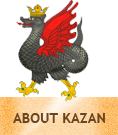The Kazan Kremlin

The Kazan Kremlin is a unique historial and cultural monument, which preserved elements of 3 epochs: tatar, russian and european. Architectural traditions of Bulgar, Golden Horde, Medieval Kazan-Tatar, Italian and Russian culture are interlaced here.
Kremlin hill is a cradle of Kazan. Kazan began its development from that very place. Khan’s palace, 5 stone mosques and burial vaults were situated inside the Kremlin .
 The main Kul-Sharif mosque was decorated with 8 high many-tier minarets. Wooden houses of the Tatar nobility and guard premises were also situated here.
The main Kul-Sharif mosque was decorated with 8 high many-tier minarets. Wooden houses of the Tatar nobility and guard premises were also situated here.
Quadrangular mosques with cupolas, minarets with patterns were the decoration of the Kazan Kremlin.
Most part of wooden walls and towers of the Kazan Kremlin were destroyed during the capture of the city in 1552. Ivan the Terrible, having understood the expedience of Kazan location and its importance for the security of the eastern borders of Russia, decided to reconstruct the Kazan Kremlin and to make an unassailable fortress.
Walls and towers of the Kazan Kremlin were built in 1556-1562 according to the decree of Ivan the Terrible by Pskov masters Ivan Shiryay and Postnik Yakovlev. Whole brick and stone Kremlin was constructed at the end of XVIII century.
The name of Postnik Yakovlev the most outstanding architect of XVI century is famous for the construction of St.Basil’s Cathedral on the Red Square in Moscow and Holy Dormition Monastery of Sviyazhsk.
The territory of Kremlin was extended for 120 meters, but the lay-out was not changed. Building material – white limestone - was brought from another bank of the Volga river. Southern and northern walls with Spasskaya tower and Taynitskie gates were constructed first. The rest of the walls were kept wooden oaken for a long time and only in XVII century were substituted by brick ones.
The Kremlin walls are rather compound engineering installatons. In combination with towers and ditches they met all the security requirements. The lower parts of walls were provided with niches with loopholes for the cannons and special chambers for storing gunpowder, round shots, tar barrels, sand and stone.
 The towers played the great role in defence of the Kremlin. There 13 of them in XVII century. Only 8 of towers remained till today, 5 of them had the gates to the Kremlin. There are only 2 tower gates functioning for today – Spasskaya and Tainitskaya towers.
The towers played the great role in defence of the Kremlin. There 13 of them in XVII century. Only 8 of towers remained till today, 5 of them had the gates to the Kremlin. There are only 2 tower gates functioning for today – Spasskaya and Tainitskaya towers.
Brick walls of the Kazan Kremlin considered to be one of the most unassailable in Russia. As the borders of Russia moved to the south and east the Kazan Kremlin gradually lost its military function and strengthened its administrative function. And this fact found the reflection in the Kremlin’s architectural image. This image lost Tatar traits, acquiring Russian and Western European traits.
Since 1992 the Kazan Kremlin is being formed as the representative center of the Republic of Tatarstan. The residence of the President of the Republic of Tatarstan Mintimer Sh.Shaimiev is situated in Kremlin.
“Kazan Kremlin” state historical architectural museum reserve, created in 1994, started systematic scientific study of the complex of the Kazan Kremlin.
“Kazan Kremlin” museum reserve together with Ministry for culture of the Republic of Tatarstan, Institute for History of the Academy of Sciences of the Republic of Tatarstan and Kazan State University every year perform archeological dig. Findings, being the evidence of the existence of the Bulgar fortress on the Kremlin hill in X-XI centuries, are of great interest.
The architecture of the Kazan Kremlin is a unique combination of two main religions – Islam and Orthodoxy.
The Kazan Kremlin is the object of historical and cultural heritage of federal level and one of the most important objects of cultural heritage of the Republic of Tatarstan.
In 1998 historical architectural complex was included in the preliminary UNESCO World Heritage list and in November 2000 it was added to the list of the World Cultural Heritage
Architect: Postnik Yakovlev, Ivan Shiryay
Date of reconstruction: XVI century







